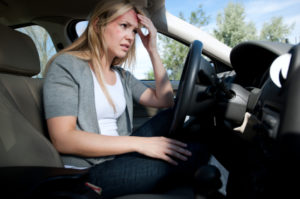5 Tips for Finding the Lowest Auto Insurance Rates
 Far too many drivers just accept the high costs of car insurance. However, there are ways to get lower rates. One way is to use the following tips in your search for low-cost coverage.
Far too many drivers just accept the high costs of car insurance. However, there are ways to get lower rates. One way is to use the following tips in your search for low-cost coverage.
You can search for car insurance rates right here when you insert your ZIP code in the FREE box!
Finding low cost car insurance should usually not include dropping coverage or lowering coverage limits; both will leave you financially vulnerable in the event of an accident or other loss. It also doesn’t include lying on your car insurance application in a bid to get lower rates; such inaccuracies are actually fraud.
#1: Improve Your Risk
Before you even begin your search, you need to try to improve your risk in the eyes of car insurance providers. All insurers use a set of factors to determine a driver’s risk of filing a claim in the future, so if you can improve some of those factors, then you can improve your risk profile as a driver. This will result in lower car insurance rates.
The most obvious factor is your driving record. Past accidents and tickets make it seem as if you are more likely to have an accident in the future; they will raise your rates. Such events stay on your driving record for three years, so try to keep your record as clear as possible.
 In the meantime, take a driving safety course approved by your state’s department of motor vehicles. For instance, the NY Department of Financial Services outlines that insurers must offer a discount for three years when a driver takes an approved classroom or online class; drivers can also get up to four points removed from a driver’s license.
In the meantime, take a driving safety course approved by your state’s department of motor vehicles. For instance, the NY Department of Financial Services outlines that insurers must offer a discount for three years when a driver takes an approved classroom or online class; drivers can also get up to four points removed from a driver’s license.
Another option is to improve your credit. Insurance providers use a correlation between poor credit and high accident rates to charge those with bad credit higher insurance rates to offset the perceived risk. Improving your credit will also allow you to get better insurance rates in those states that allow insurers to use credit.
The Federal Reserve offers tips on improving your credit, such as paying down credit card debt and checking your credit report at least once a year.
While improving your credit will take time, it is well worth it for your insurance rates and your finances.
Other options for reducing your risk include driving a safer vehicle, parking your car in a locked garage, or monitored lot when not in use and installing an anti-theft device. Find options that are within your reach and budget.
#2: Know Your Coverage
You also need to know how much coverage you want before you start to look for rates. Just guessing at coverage levels is not going to get you the protection you need. Your best bet is to follow the advice of experts when determining your coverage levels.
 First, experts recommend liability levels much higher than the minimums required by state law. This is to protect you from lawsuits and the loss of your assets if you cause a serious accident. If you don’t have enough coverage to pay the medical bills and repair costs of those you hurt in an at-fault accident, then you will be legally responsible to pay the differences.
First, experts recommend liability levels much higher than the minimums required by state law. This is to protect you from lawsuits and the loss of your assets if you cause a serious accident. If you don’t have enough coverage to pay the medical bills and repair costs of those you hurt in an at-fault accident, then you will be legally responsible to pay the differences.
The industry specialists at the Insurance Information Institute recommend no less than $100,000 in liability coverage per individual and $300,000 for the entire accidents. Additionally around $100,000 in property damage liability is also recommended to pay repair bills.
Next, most insurance experts also recommend that you have full coverage in the form of collision and comprehensive. This is to pay for the damages to your vehicle from an at-fault accident, weather-related damages, or theft. Only full coverage offers this protection.
The experts at the National Association of Insurance Commissioners recommend that the only time that you should forgo full coverage is if your vehicle is worth less than $1,000. Barring having an older vehicle with high mileage, you should have full coverage to protect you against damages.
Furthermore, many experts also recommend levels of uninsured/underinsured motorist coverage and some type of medical payments insurance. You might also consider options such as towing, roadside assistance, and rental car reimbursement.
Free Car Insurance Comparison
Compare Quotes From Top Companies and Save
Secured with SHA-256 Encryption
#3: Use the Same Coverage
 One of the main reasons why you need to know your levels of coverage before you start your search is that you need to get rate quotes for exactly the same amount of coverage. Then you can compare your rates side-by-side to see which insurer is offering the best rates.
One of the main reasons why you need to know your levels of coverage before you start your search is that you need to get rate quotes for exactly the same amount of coverage. Then you can compare your rates side-by-side to see which insurer is offering the best rates.
If you get rates for different amounts of coverage, you won’t be able to compare your quotes equally. It would be like comparing the cost for a sedan with that of a performance sports car. Just like with different rates of coverage, one is offering more options for your money.
#4: Get Many Quotes
When you are searching, you need to make an effort to get as many quotes as possible. Do not be sidetracked by a quote that looks affordable as you might find another rate that is even more so. Your quotes will be good for a few days at least; car insurance quotes aren’t offered under the assumption that you will be purchasing coverage immediately.
You also need to get quotes from a variety of car insurance providers. You will likely first turn to those large car insurance carriers that advertise extensively on television, on the Internet and in print. By all means get quotes for coverage from the major carriers, but don’t stop there.
Most of the big companies in the insurance industry offer their best rates to those with spotless records, perfect credit, and safe cars.
If you stray from this perfect customer model, then you might not find the best rates with the most well-known insurers.
 There are many large insurers that don’t advertise as heavily, but they may be a good option for you. Furthermore, you might also find your best rates with a smaller, regional provider. The only way that you will know which provider will offer you the best rates is to get quotes for coverage.
There are many large insurers that don’t advertise as heavily, but they may be a good option for you. Furthermore, you might also find your best rates with a smaller, regional provider. The only way that you will know which provider will offer you the best rates is to get quotes for coverage.
Get rate quotes from companies that are big, companies that are small and everything in between. Most experts recommend at least three quotes, but the more quotes you get; the more likely you are to find the one insurer that has a great rate for you.
#5: Use Quote Comparison Websites
To make your rate quote search go faster with less effort on your part, utilize a quote comparison website such as this one. Quote comparison sites do the bulk of the legwork for you, allowing you to get more quotes in less time and with less effort.
 If you get quotes on your own, then you will have to fill out an application for each individual quote you get. You can do this in person, over the phone or online in most cases, but it takes time. If your goal is to get eight quotes, and each quote averages an hour of your time, then getting those quotes will be the same as a full workday where you work through lunch.
If you get quotes on your own, then you will have to fill out an application for each individual quote you get. You can do this in person, over the phone or online in most cases, but it takes time. If your goal is to get eight quotes, and each quote averages an hour of your time, then getting those quotes will be the same as a full workday where you work through lunch.
Comparison websites take your information on one application, and they send that application out to a variety of insurance providers. So you spend only one hour for six to eight quotes rather than eight hours for quotes on your own.
The benefits of comparison sites extend beyond just saving time and effort. You can use them at any time of day and from any computer with Internet access. You also don’t have to worry about using the same amount of coverage for each quote because all of your quotes will be based off the same application.
Furthermore, you will likely get quotes from car insurance providers that you have never heard of, and those might be the best quotes that you find. Similarly, you can even use quote comparison websites along with getting your own quotes so you can get quotes from particular providers that might not have been in your quotes from the site.
Before You Buy
Most experts agree that comparing quotes is one of the best ways to find savings for your car insurance, but you must realize that the shopping process is just the first step. There are a few other areas you need to look into before you buy your coverage.
Price is not the only important factor when shopping for car insurance.
You want your insurer to be financially strong so that you can rely on them. If you have to file a claim at some future date, you don’t want to find out that your insurer can’t pay because they botched their finances. Use financial ratings from ratings organizations such as Standard and Poor’s and Fitch Ratings to make sure your prospective insurance companies are financially strong.
 Next, you also want an insurer with a true commitment to customer service. Their reputation needs to bear that out, not a spokesman on a commercial claiming they care about the customer. Look for customer complaints with your state’s department of insurance or the Better Business Bureau, and view customer-based ratings with independent ratings providers like J.D. Power and Associates.
Next, you also want an insurer with a true commitment to customer service. Their reputation needs to bear that out, not a spokesman on a commercial claiming they care about the customer. Look for customer complaints with your state’s department of insurance or the Better Business Bureau, and view customer-based ratings with independent ratings providers like J.D. Power and Associates.
After you have found a company that is financially strong and has a stellar reputation concerning customer service, then you are ready to buy a policy!
Your search for car insurance quotes can begin right here once you place your ZIP code in the FREE search tool!
